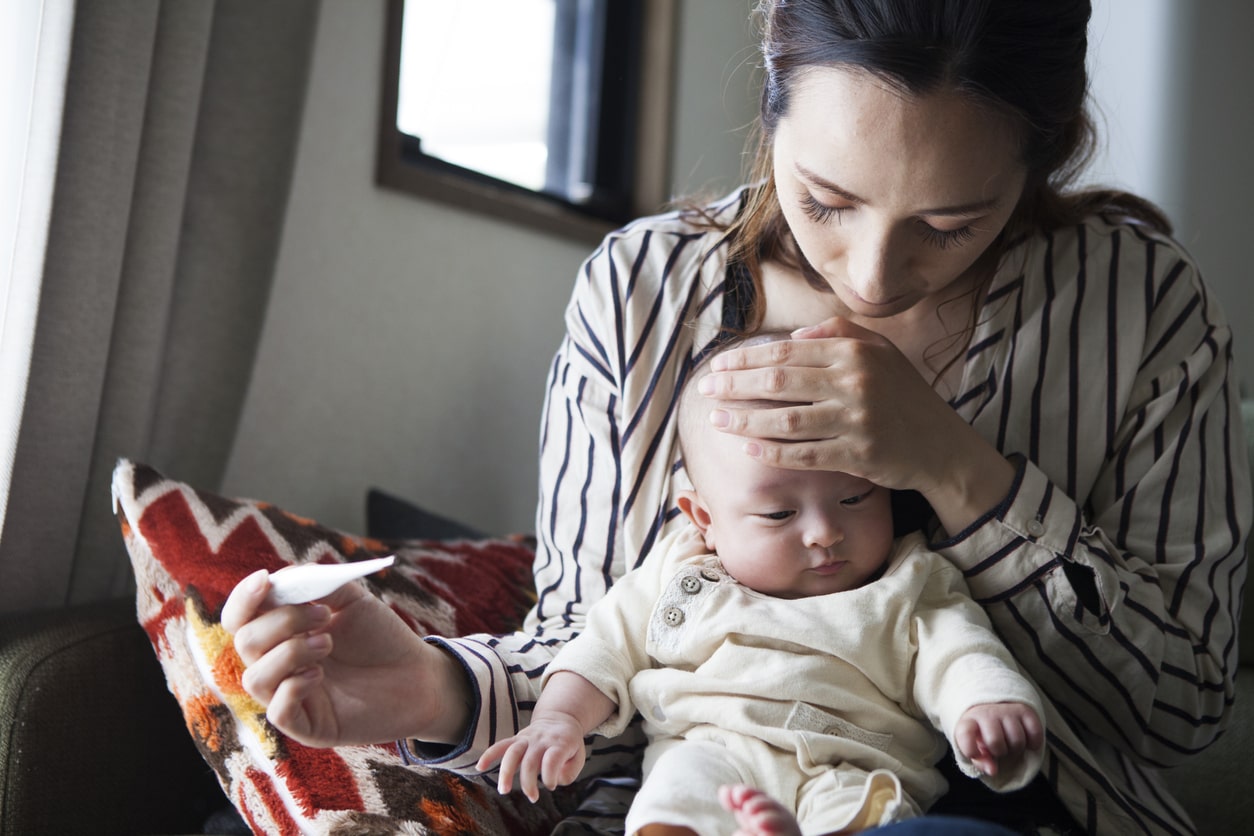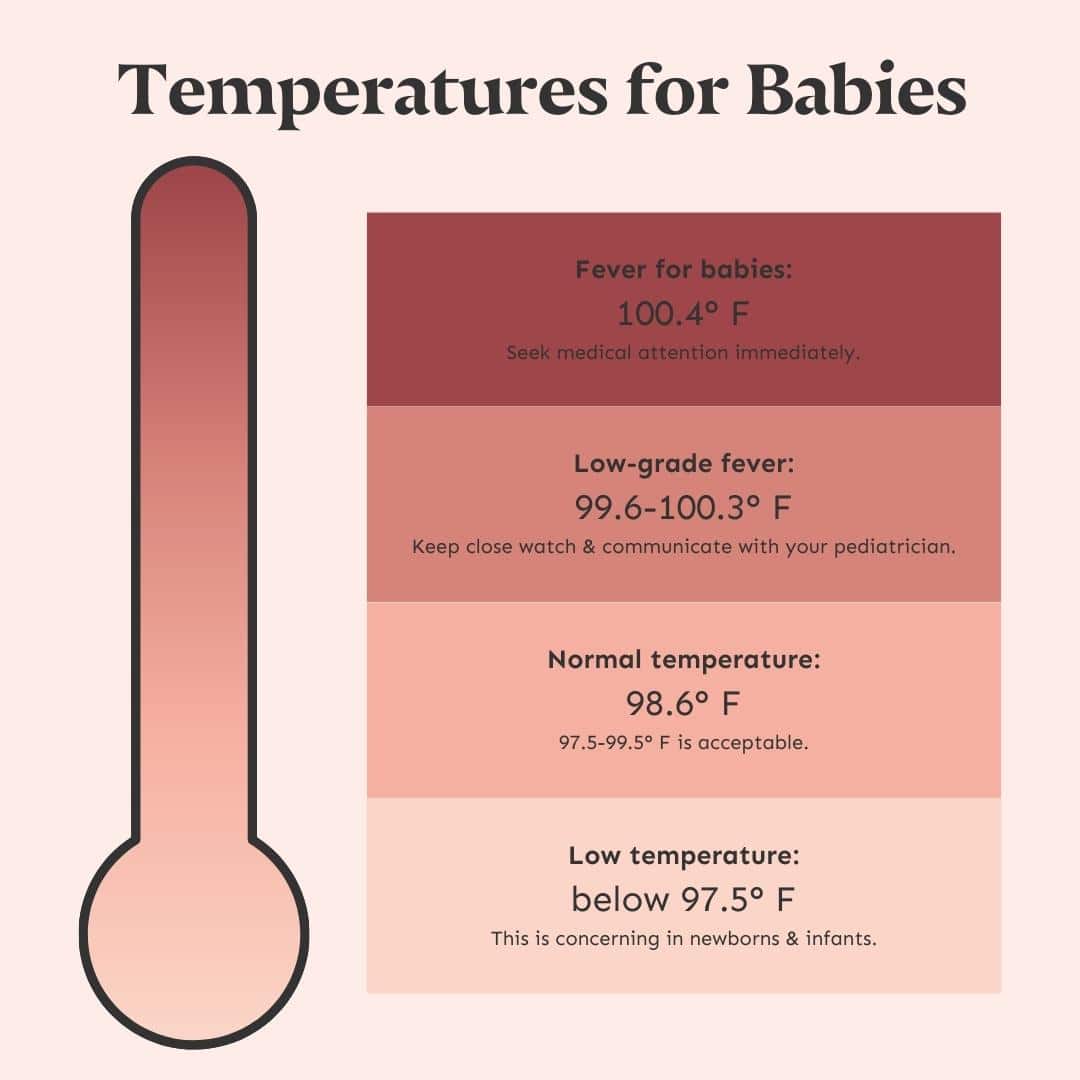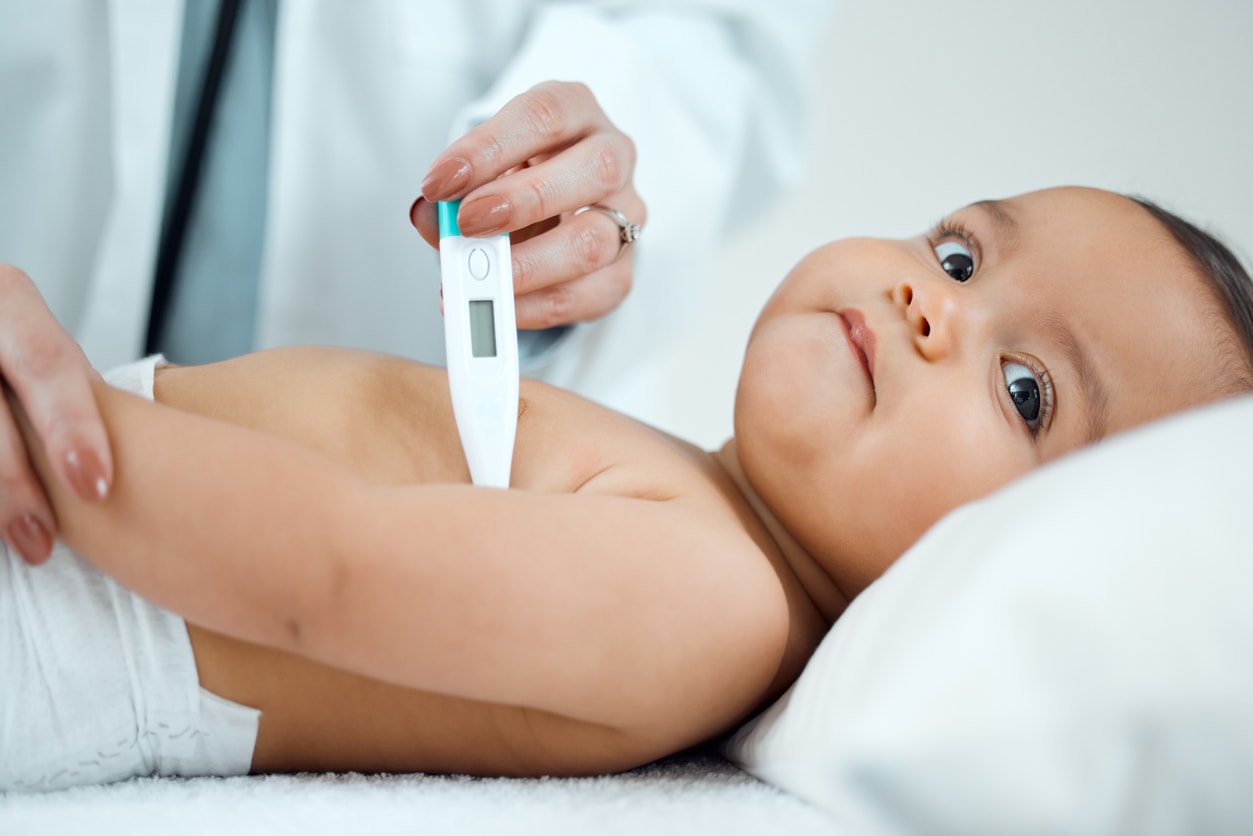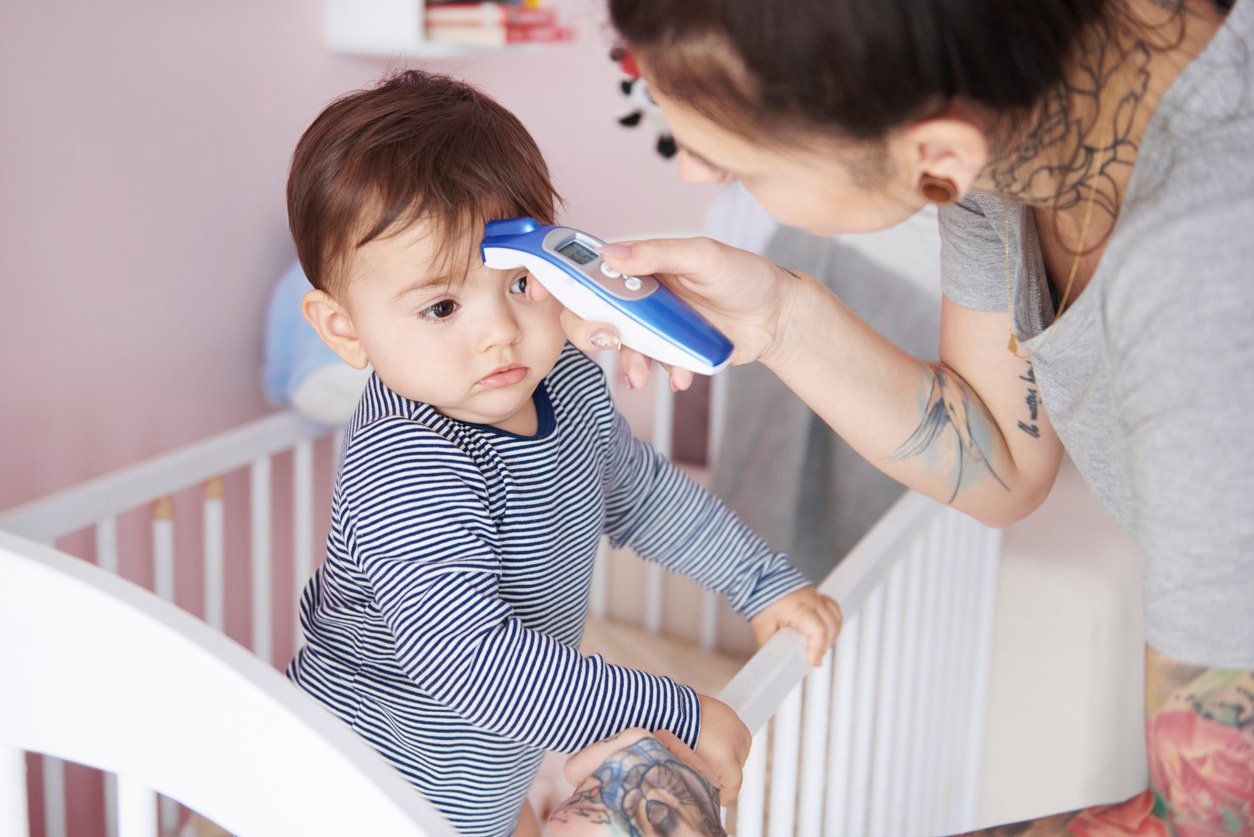
![]()

Taking your baby’s temperature is essential to their health and well-being. Knowing how to take their temperature accurately and efficiently can help you feel more at ease and provide peace of mind regarding your baby’s health. It’s helpful to have step-by-step instructions to follow to take your baby’s temperature accurately and quickly. We’ve compiled this guide with useful tips to ensure the process is as easy and stress-free as possible.
Quick Contents
What is a Normal Temperature for a Baby?
A normal temperature for someone is 98.6 degrees Fahrenheit. However, 97.5-99.5 degrees Fahrenheit is acceptable.2
A baby’s environment, what they wear, and the time of day can affect their temperature. Unless your baby appears noticeably ill, you will often feel a temperature change when touching their skin. If your baby is cool or warm to the touch, consider the room’s temperature. Is it hot? Do they have too many layers on? Or conversely, is it chilly, and they are dressed too lightly? Have they been sleeping snuggled skin to skin? Do they need socks or a hat? Do they have too many blankets? Adjusting some of these variables may be all you need to do to help your baby feel more comfortable.1,2
Temperature Indicating a Fever in a Baby
Typically, 99.6-100.3 degrees Fahrenheit is a low-grade fever, and 100.4 is considered a fever by most practitioners. Fever alone is not an illness; it is the body’s way of indicating something is wrong, like an illness or infection, and it must mount a defense.1,2

Is a Low Temperature Serious in a Baby?
Low temperatures are concerning in newborns and infants. If your baby has a temperature below 97.5 degrees Fahrenheit, it is vital to determine the cause. Did they just have a bath? Were they in the water for an extended time? Have you dried them off well?
Low temperatures can be caused by an inability to regulate body temperature, low blood sugar (hypoglycemia), or a serious infection.1,2,3
Types of Thermometers To Use
The American Academy of Pediatrics recommends using digital thermometers for infants and children. You should never use old-style glass mercury thermometers to take a baby’s temperature because the glass can break and splinter, and mercury can spill. Glass thermometers can be dangerous and toxic. If you have a mercury thermometer, contact your local trash collecting company for directions on how to dispose of it.1,3,4,5
Several low-cost digital thermometers are on the market, providing a fast, effective way to take your baby’s temperature. Digital (electronic) thermometers fall into a few main categories:1
- Multiuse digital thermometers are simple to use and provide accurate results. They can be used under the armpit (axilla temperature), in the rectum (rectally), and orally. However, you do not take a child’s temperature by mouth until age 4.
- Temporal artery thermometers measure your child’s temperature by scanning the blood vessels in the forehead. It is accurate when performed correctly and less invasive than a rectal temperature. These can be used on children of any age.
- Tympanic membrane thermometers measure the temperature in your child’s ear canal. When done correctly, these also provide accurate readings, but they are not recommended for children under six months of age because their ears and ear canals are too small to get accurate readings.
Where Can You Take a Baby’s Temperature?
You can take your baby’s temperature in their bottom, under their armpit, and forehead. Rectal temperatures are the most accurate, followed by forehead and armpit temperatures. These recommendations are approved for babies 0-12 months.1
Always read and follow the instructions with the specific thermometer packaging. If you decide to use a multiuse digital thermometer, it is a good idea to purchase two and label one for the axilla (armpit) and one for the anus. Labeling will prevent cross-contamination. Always clean the thermometers per packaging instructions after every use. The same idea goes if you have multiple babies. Separating and labeling rectal thermometers for each baby can reduce the spreading of infection from one child to another.1,2,3,4
How To Take an Armpit Temperature

Axillary temperatures are an effective screening method to assess your baby’s temperature. They are not as invasive as rectal temperatures and offer a safe option posing no risk of injury to your child. If you are concerned with the reading, you can then recheck their temperature with another more accurate method.1
Follow these steps to take an axillary temperature:1
- Place your baby in a comfortable position on your knee or at a changing table.
- Make sure their armpit is dry.
- Place the tip of the thermometer in their armpit.
- Gently hold their arm close to their body.
- Hold the thermometer for the recommended time, usually 10-15 seconds.
- Some thermometers will beep when ready.
- Note the temperature on the display.
How To Take a Rectal Temperature
Rectal temperatures are considered the most accurate method to take a baby’s temperature, especially for children younger than three months. If your child appears ill, you may want to skip the axillary method and get a rectal temperature. However, the most significant risk when taking a rectal temperature is the chance of perforation, meaning the thermometer can cause trauma to the rectum by tearing or poking a hole in the surrounding tissue. You should never feel resistance when inserting a rectal thermometer; if you do, remove it immediately. When done gently and properly, rectal temperatures pose minimal risk of perforation.1
Follow these steps to take a rectal temperature:1
- Lubricate the thermometer with a small amount of petroleum jelly.
- Hold your baby bottom-up on a firm surface. You can lay your child belly-down on your lap or a changing table. Place one hand on their lower back to prevent them from moving. Use your finger and thumb on the stabilizing hand to slightly part the buttocks.
- Alternatively, you can lay the child on their back on a firm surface. Draw their legs and knees up as if changing a diaper and hold them toward the chest to expose the bottom.
- Turn on your lubricated digital thermometer.
- Gently insert the thermometer into the anus. There should not be any resistance. The recommendation is a half-inch for babies six months and younger and about an inch for older children.
- Hold the thermometer in place until it beeps.
- Note the temperature on the display; write it down.
- Clean the thermometer immediately per package instructions or by using disinfecting soap and alcohol swabs.
How To Take a Forehead Temperature

Temporal artery thermometers use infrared technology to take a baby’s temperature by scanning the temperature of blood vessels and tissue in the forehead area. These thermometers are increasingly used in hospitals, clinics, and doctor’s offices. They are the newest type of thermometer on the market.1
Both axillary and rectal methods can wake a sleeping child, whereas a forehead temperature can be done in just a few seconds without disturbing the child.
There are touch and non-touch temporal artery thermometers. Accuracy may vary by type and model, and these options are pricier than simple digital thermometers. Again, a rectal temperature will be more accurate for children under three months old. If you are considering the purchase of a temporal artery thermometer, you may want to call your pediatrician’s office for their recommendation. Although most thermometers work similarly, always read your model’s instructions.
Taking a Non-Touching Forehead Temperature
Follow these steps to take a non-touch forehead temperature:1
- Turn on your device.
- Aim the thermometer at the forehead less than an inch from the skin.
- Keep still and press the measurement button.
- Note the final reading and write it down.
Taking a Touch Forehead Temperature
Follow these steps for a touch forehead temperature:
- Turn on your device.
- Aim the thermometer at your child’s forehead, contacting the skin gently.
- Sweep along your child’s hairline toward their ear, maintaining gentle contact.
- Note the final reading on the display and write it down.
When your child is sick, the world stops around you as you desperately want to make them well. Even the most level-headed, seasoned parents worry about a sick child. Knowing when and how to take your baby’s temperature confidently can help calm a stressful situation. Keep records of your baby’s temperature if you must report them to a health provider. Babies can get sick quickly and cannot tell you what is wrong. Do not hesitate to call your provider if your child is ill. It is always better to have a pediatrician tell you nothing is wrong than to delay seeking treatment only to realize that you should have sought help earlier.
